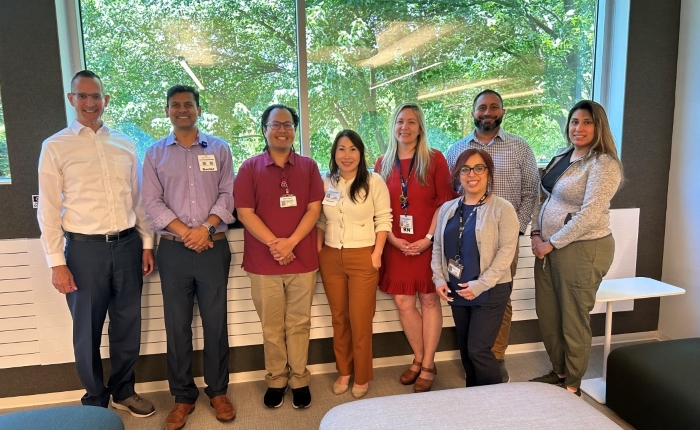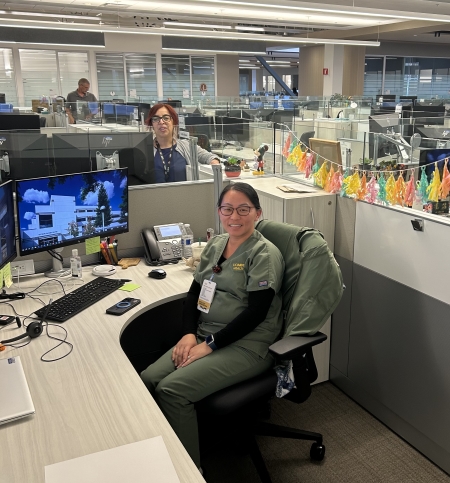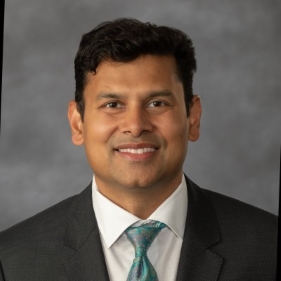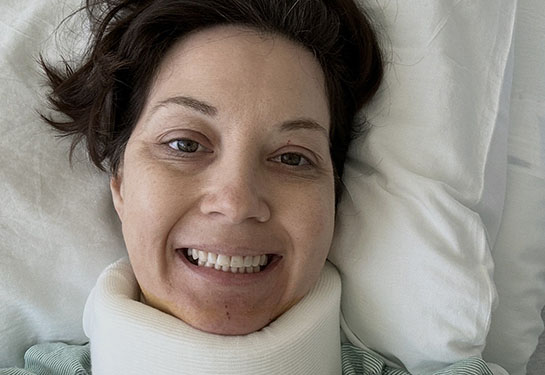Meet the team providing patient care at home

As a boy, Vimal Mishra joined his physician grandfather for house calls near where they lived in India. He has fond memories of his grandfather providing attentive care in the most convenient, comfortable place for each patient.
This early exposure to patient-centered care deeply influenced Mishra, shaping his vision for the future of health. Now as an acute care physician himself and associate chief medical officer, Mishra wishes it could be that simple.
“That was the best kind of care I saw for the family and the patient, but he was able to see maybe one or two patients at the end of the day,” he said. “It’s not scalable.”
The health care industry adapted by building hospitals and clinics, to organize care and resources around physical locations. Then it asked patients to visit providers for their care, rather than the other way around. It was an imperfect solution.
Now we are at a critical moment in history where technology is enabling a return to care at home, while streamlining internal workflows to free up providers’ time.
We are disrupting that brick-and-mortar system."—Vimal Mishra, associate chief medical officer
“We can provide the same resources around the patients. We are disrupting that brick-and-mortar system,” said Mishra.
His team at UC Davis Health is at the forefront of it. They call it the Connected Care Center.
What is the Connected Care Center?
The Connected Care Center (CCC) is a team and technology that helps provide patient-centric care at the right time and the right place. The goal is to use technology to take care of patients where they are.
The CCC is comprised of five programs:
- ED to Home: Follow-up care at home after certain ER visits
- Urgent Care at Home: Care visits at home for timely medical concerns
- Post Discharge Bridge Clinic: Care for high-risk patients transitioning from hospital to home
- Remote Patient Monitoring: Medical tools to monitor and connect certain patients from home
Conceptualized by Mishra and Executive Director of Ambulatory Operations BJ Lagunday, the CCC aims to “improve how we deliver care, making it more convenient and accessible to everyone,” said Lagunday.
How does it work?

A patient’s journey with the CCC team begins when a provider refers them. Let’s say a patient suffers from chronic hypertension but refuses to return to the ER during a future crisis. A nurse or physician might refer them to the CCC’s new remote monitoring program. After installing an at-home blood pressure monitor, the patient’s readings would instantly send to the CCC care team and simultaneously log to their medical chart.
“They have access to us and we have access to them,” said Crystal Hapgood, the CCC’s nurse manager. “This is the digital face of the program that allows us to reach out with real-time support.”
After a month or two of live monitoring, education and support from providers, the patient should be ready to return to regular physician and clinic appointments, armed with tools and knowledge.
Importantly, the workflow is invisible to the patient. The CCC is an internal program that coordinates a seamless patient experience between different care modes, ensuring no one falls through the cracks.
Meet the team
Unlike a brick-and-mortar clinic, the CCC isn’t a fixed location. It’s comprised of an interdisciplinary team of clinical providers and support staff:

at the Health Administration Services building.
- Physicians
- Nurses
- Medical assistants
- Pharmacists
- Practice manager
- Nurse manager
- Patient service representatives
The team relies on strong partnerships with clinicians across the system. Any nurse or physician at UC Davis Health can refer patients to the CCC. About 80% of the CCC’s patient referrals come from the nurse triage line, for example.
Finally, the right technology plays its own critical role. The CCC’s model is based on digitally enabled care in the form of advanced logistics, remote clinical monitoring, mobile clinics and more, all seamlessly integrated into existing EMR workflows.
Why is it important to patients and UC Davis Health?
The Connected Care Center program aims to enhance traditional healthcare delivery by offering patient-centered acute care at home, making it more accessible and efficient for patients and providers alike.
Its first program, Express Care, was conceived during the COVID-19 pandemic as a way to expand primary care. By offering patients timely video visits, UC Davis Health referred fewer patients to external urgent care.
“This way, the information on the patient’s chart stays within our system, so that the primary care doctor is up to date,” said Operations Manager Tom Nguyen.
The model is proving scalable:
- Since launching Urgent Care at Home, the CCC has reduced unnecessary visits to the ED. Of the 815 patients they treated between September 2023 and February 2024, 77% said they would have gone to the ED if not for at-home services.
- Express Care alone saw 24,000 patients last year and is on track to match the level this fiscal year, with an average 75 patients per day.
Patients are happy receiving care at home. Whether through a video appointment, a remote blood pressure monitor or a home visit from urgent care, UC Davis Health patient testimonials have been overwhelmingly positive, according to the Net Promoter Score survey.
And while technology plays an important role in the future of health care, it can never replace primary care clinics or hospitals, much less the providers who forge personal connections with their patients. Just like Mishra’s grandfather did.
“Because at the end that’s what really heals you,” said Mishra.




